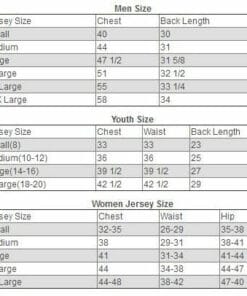Bruin Pride: The UCLA Bruins Jersey Collection
The UCLA Bruins, representing the University of California, Los Angeles, have not only made their mark in the annals of collegiate sports through their impressive achievements but also through the iconic status of their athletic apparel. The UCLA Bruins jersey, in its various incarnations, embodies a rich history of athletic excellence, tradition, and innovation. This article delves into the evolution of the Bruins’ jerseys, their significance, and the impact they’ve had on sports culture, culminating in a comprehensive exploration of one of college sports’ most iconic symbols.
The Origins of UCLA’s Athletic Apparel
The early jerseys of the UCLA Bruins were a far cry from the advanced, high-tech apparel of today. In the initial days, the Bruins sported simple designs, with the primary colors being a deep powder blue and gold. These colors were chosen for their symbolic significance; blue represents the sky and the ocean, signifying depth and stability, while gold is a nod to the Golden State of California, representing excellence and success.
Evolution of the Jersey
The 1950s to 1960s: The Wooden Era
The era of Coach John Wooden, from 1948 to 1975, was a transformative period for the UCLA Bruins, especially in basketball. It was during this time that the Bruins’ jersey began to gain national attention. The introduction of the iconic UCLA stripe, a vertical stripe on the shoulder, became a hallmark of the Bruins’ identity. This design element was not just aesthetic; it symbolized the Bruins’ streamlined approach to the game and their emphasis on speed and agility.
The 1970s to 1980s: A Shift in Materials
With advancements in fabric technology, the late 70s and 80s saw a significant shift in the material used in sports jerseys. The UCLA Bruins were among the early adopters of synthetic fabrics, moving away from the traditional cotton. This transition marked a significant step in improving athletic performance, as these new materials offered better sweat management, durability, and comfort.
The 1990s to 2000s: Brand Partnerships and Innovation
The late 20th and early 21st centuries saw the UCLA Bruins entering into partnerships with leading sports apparel brands. These collaborations led to the introduction of cutting-edge technology in jersey design, including moisture-wicking fabrics, more durable materials, and innovative fits that enhanced athletic performance. The jerseys also became a statement of fashion, incorporating modern design elements without straying far from the traditional colors and motifs that defined the Bruins’ identity.
The 2010s to Present: Sustainability and High Technology
The most recent iterations of the UCLA Bruins jersey reflect a commitment to sustainability and the use of recycled materials, aligning with broader societal shifts towards environmental consciousness. The integration of high-tech features, such as body temperature regulation and aerodynamic designs, demonstrates the ongoing evolution of the jersey to meet the needs of modern athletes.
Impact on Sports Culture and Merchandising
The UCLA Bruins jersey has transcended its role as mere athletic apparel to become a symbol of pride, identity, and culture among students, alumni, and sports enthusiasts. The demand for replica jerseys and related merchandise has turned the Bruins’ apparel into a significant aspect of the university’s branding and revenue generation. This merchandising success underscores the deep connection between the team’s on-field achievements and its cultural and economic impact.
Frequently Asked Questions (FAQs)
What does the UCLA stripe signify?
The UCLA stripe is a vertical stripe found on the shoulder of the Bruins’ jerseys. It is a design element that symbolizes the team’s emphasis on speed, agility, and streamlined performance. It has become an iconic part of the Bruins’ identity.
How have the materials used in the jerseys changed over time?
The materials have evolved from natural fibers like cotton to synthetic, high-tech fabrics that offer better sweat management, durability, and comfort. This transition has helped improve athletic performance and player comfort during games.
Can fans purchase authentic UCLA Bruins jerseys?
Yes, fans can purchase authentic UCLA Bruins jerseys from various sources, including the university’s official athletics website, licensed sports apparel retailers, and other online platforms. These replicas are designed to closely mimic the appearance and quality of the actual jerseys worn by the athletes.
How does the design of the UCLA Bruins jersey compare to those of other collegiate teams?
While each collegiate team’s jersey has its unique aspects, the UCLA Bruins jersey is particularly notable for its iconic UCLA stripe, distinctive color scheme, and the balance it strikes between tradition and innovation. These elements make it stand out in the landscape of collegiate athletics apparel.
What initiatives has UCLA taken towards sustainability in jersey production?
UCLA has shown a commitment to sustainability by incorporating recycled materials into their jerseys and partnering with apparel companies that prioritize eco-friendly production processes. This approach reflects a broader commitment to environmental responsibility in the sports industry.
Conclusion
The UCLA Bruins jersey is more than just athletic wear; it’s a symbol of the university’s rich sporting heritage, a beacon of innovation in apparel design, and a cherished item among its passionate fan base. From its humble beginnings to its current status as a high-tech, eco-friendly garment, the Bruins jersey tells a story of evolution, tradition, and the relentless pursuit of excellence. As the UCLA Bruins continue to forge their path in collegiate sports, their jersey remains a timeless reminder of where they’ve been and where they’re headed.
Shop Now: Custom UCLA Bruins Jersey






















